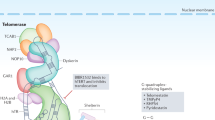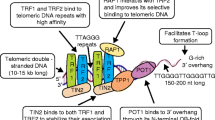Abstract.
Telomeres are protective structures located at the ends of all eukaryotic chromosomes. Telomere shortening upon cell division restricts the proliferative capacity of most normal human cells due to the lack of telomerase, an enzyme synthesizing telomeric DNA de novo. Since most tumor cells are reliant on the activity of telomerase to maintain the stability of predominantly short individual telomeres, inhibition of this enzyme presents an attractive approach for a mechanism-based anticancer therapy. Here, we review advances and obstacles in targeting telomerase and telomeres and discuss potential applications of such approaches for the clinic.
Similar content being viewed by others
Author information
Authors and Affiliations
Corresponding author
Additional information
Received 9 November 2006; received after revision 8 December 2006; accepted 17 January 2007
Rights and permissions
About this article
Cite this article
Zimmermann, S., Martens, U.M. Telomeres and telomerase as targets for cancer therapy. Cell. Mol. Life Sci. 64, 906 (2007). https://doi.org/10.1007/s00018-007-6481-8
Published:
DOI: https://doi.org/10.1007/s00018-007-6481-8




